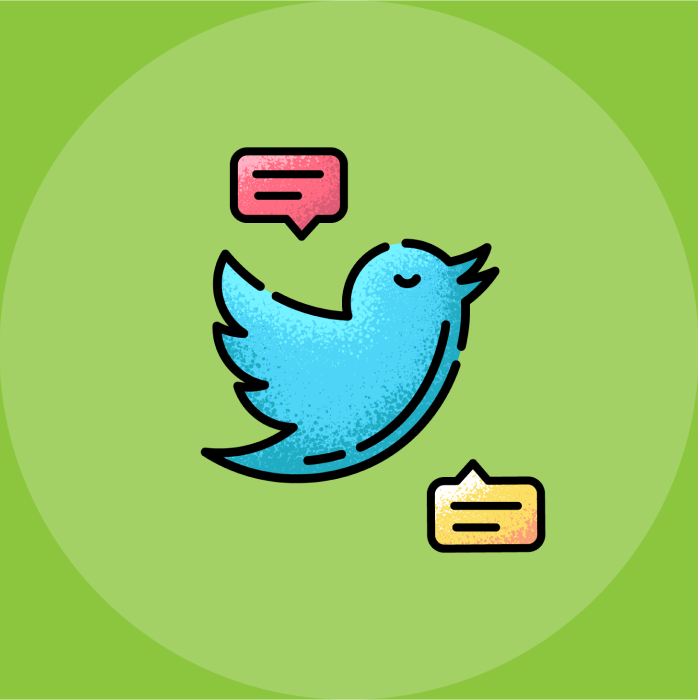In order to cut through the static, you need to create posts that stand out from the clutter. Follow the article below to learn about good engaging twitter posts.
It’s not a secret to anyone that Facebook is the most popular social media platform on the planet. And now, as Facebook also owns Instagram, these two platforms create a tandem that can possibly exclude all other social media platforms in terms of digital marketing.
But where does it leave Twitter? Is it losing its popularity?
It may seem so, especially considering how much money brands pour into creating content for other social media platforms.
However, Twitter still stands strong against its competitors in social media marketing and, in some instances is even more effective than other platforms.
According to the statistics by WordStream:
● Twitter ad engagement is 23% (average ad engagement rate on Instagram is 4.3%)
● Twitter’s site referral traffic has been growing 6% year-by-year, which indicates the platform’s steady popularity
● Twitter users are 53% more likely to be the first to buy new products, and 92% of them are open to the brand presence on Twitter, making it the most inclusive social media platform
Of course, no matter how long and steady of a presence you have on Twitter, you still can have zero engagement, and the platform is not always the one to blame.
The lack of engagement can be the consequence of the content you upload to Twitter, mainly, the copy of your tweets.
If you remember, Twitter has started as a platform where people could easily share news updates with others, and it still remains the number one reason why people use Twitter to this day.
Thus, the way you present the information in your tweets plays a great role in engaging your followers and Twitter users in general.
So, writing good tweet copies will be our topic today, as we go through the top 5 copywriting tips and analyze some examples of good engaging tweets.
1. Start with Audience Analysis
Before we go to writing tweets, first, we need to figure out who they will address.
Audience analysis is an essential part of writing any copy, not just a tweet. The data collected during this analysis helps shape the following characteristics of a good copy:
● attention value – a good copy is easy-to-read, that’s why it effectively retains the attention
● educational value – a reader can always draw some valuable conclusions from a good copy
● suggestive value – a good copy should guide a reader to a certain conclusion
● sentimental value – a good copy always addresses certain emotions; this is what makes the copy memorable
To create a copy that carries all these characteristics, you need to know your audience very well. Luckily, such analysis won’t necessarily take too long since you can use Twitter analytics to see who your followers are and also track their behaviors.
For instance, to address a sentimental value in your tweet copy, you can study your audience’s interests through Twitter Analytics:
This information can also come in handy if you decide to promote your Twitter profile through native ads and make them more targeted.
You can also go through the general number of impressions, engagements, and check out the engagement rate for all your tweets to see which ones your audience likes better:
You can use this information to come up with ideas for your future tweet copies. Aligning the contents of your tweets with your audience’s interests and content preferences can significantly impact the engagement but will also make your copies more targeted.
The structure of the tweet copy has a great impact on the flow of the narrative and on how your audience will perceive your message in general.
To help you achieve the positive effect with your tweets, there are a few copywriting formulas you can employ. These formulas allow you to present the same message from different perspectives. Let’s take a look.
a) Problem-Agitate-Solve
Take a look at the following tweet:
This tweet simply shares a blog post, but it’s a good example of the problem-agitate-solve (PAS) copywriting formula in action. As you can see, it focuses on the emotional aspect of the message, namely by addressing the needs and challenges of your customers. By the way, this is another point in favor of doing extensive audience research before writing tweets.
To successfully use this formula in your tweets, follow these three steps:
● define the problem
● agitate the most displeasing aspects of this problem
● offer a solution
You can also include some numbers or statistics to add more credibility to your message.
b) AIDA
Let’s investigate the following message from KFC:
In terms of copywriting, this tweet is a good example of the Attention-Interest-Desire-Action (AIDA) formula. You can use this formula if you want to announce something on Twitter, like a new product, an upcoming event, etc.
Follow these steps to apply this formula in your tweets:
● draw the reader’s attention with an initial announcement
● increase their interest with new information or unexpected details
● spark the desire by making an attractive offer
● finish with a call-to-action
This formula works well if you want to persuade your audience to participate in an event or buy something, especially if you’re offering something unique.
c) Before-After-Bridge
Let’s take a closer look at the tweet below:
Right away, you can notice that it addresses a certain problem and offers a solution. This tweet may remind you of the problem-agitate-solve formula we mentioned a bit earlier, except it also shows the reader their world after they take advantage of the solution.
This is a good example of the before-after-bridge (BAB), and this formula consists of the following elements:
● show your audience their world before the solution
● immediately take them to the future where the solution is a part of their lives
● show how the solution you offer can benefit them and include a call-to-action
In the tweet above, the target audience has to deal with too many open windows, but Monday.com shows how their workflow can become easier with the new Creative Cloud integration.
3. Employ Psychological Tricks to Draw Attention
Now, as you have a few copywriting formulas at your disposal, we can talk more about several approaches that allow you to play with your audience’s minds a little bit and effectively attract their attention.
Let’s take a look at a few psychological tricks used in copywriting that you can also employ when writing your tweets. However, keep in mind that the use of these approaches is situational and depends on the message you would like to share.
a) FOMO
Fear of missing out, or FOMO, describes one of the most fundamental instincts of a human being – not to lag behind and always be with the crowd. As a result, a person is ready to do everything just to remain continually connected with others.
This psychological phenomenon is widely used (and often abused) in copywriting. According to Diana Adjadj, a copywriter and blogger at Subjecto, usually, a brand makes an offer limited in time, presuming that consumers don’t want to miss out on the attractive opportunity, will accept this offer.
Here’s an example of a tweet from PetSmart that addresses the fear of missing out:
In this tweet, there’s everything needed to trigger this feeling – an attractive offer and a limited timeframe.
PetSmart uses this approach quite subtly. However, you can make your tweet copy a bit more pressing using words like urgent, now, ending soon, etc. This approach is especially effective if you want to increase sales during the holiday season.
b) The Curiosity Gap
One of the goals of a good tweet copy is to sparkle the debate, which is the direct proof of engagement. The curiosity gap is the approach that can help you achieve that effect.
This phenomenon addresses a human desire to immediately get the answer to the question they don’t know how to reply to. According to Kristin Savage, a marketing specialist and a contributing blogger, this curiosity gap is one of the most popular methods in copywriting and has helped some brands improve engagement by more than 900%.
Why do people react to the curiosity gap so well?
Humans have a very inquisitive nature, and we seek every opportunity to fill in the knowledge gap if it occurs. The curiosity gap addresses this need, and that’s why copies that use it perform so well.
You can use the curiosity gap in your tweets to start a discussion with your audience. This is exactly what Burger King did in the following tweet:
This is a simple tweet with a question but no answer, but it invites the brand’s followers to join in on the discussion. And you can’t say it didn’t work – the tweet has almost 600 comments and decent engagement overall.
c) Visual Stimuli
This phenomenon is more about neuroscience than psychology.
It’s not a secret that we perceive information better when it’s visualized. The explanation for it is simple – it is easier for your brand to decipher visual stimuli.
In terms of writing a tweet copy, the statistics also support the effectiveness of visual stimuli: tweets with images receive 150% more retweets than tweets based solely on text.
Here’s a good example of the text paired with an image in Vessi’s tweet:
If this tweet were only in writing, it would take too many characters to convey the message. However, the use of a visual simplifies this message a lot and doesn’t distort the intended meaning of the tweet.
Note: keep in mind that you need to do image SEO for all your visuals as well as general keyword optimization for the text of your tweet to improve its visibility.
4. Focus on Readability
As you know, Twitter offers only a very limited amount of characters. Yet, it’s very easy to mess up your tweet copy if you stuff it with as many details as possible and make it look completely unreadable.
Since the goal of every good copy is to deliver the message without changing its original meaning, readability is essential here. So, let’s take a look at what you can do to improve the readability of your tweets and make sure your audience understands what you intend to say.
First and foremost, you need to invest more time in proofreading your tweets. It might seem unnecessary since tweets have only 280 characters, but you don’t want to embarrass your brand with childish grammatical mistakes or absolutely no punctuation marks, like in the tweet below:
What else can you do to make your tweet copy more scannable?
You can also try leveraging different types of content. Twitter users like watching videos on this platform, and images do quite well, too, as we mentioned a bit earlier. So, if there is a chance to substitute a portion of text with some type of visuals, it could help improve your tweet’s readability.
If appropriate, you can also break down your tweet using bullet points, which you can also substitute with different emoji, like in the tweet below:
However, be careful and don’t overuse emoji in your tweets because they can distort the meaning of your message.
Lastly, if you want to craft an engaging tweet copy, you also need to think about the hashtags.
Twitter was the platform that initially popularized hashtags, and it’s no surprise that tweets with hashtags get 100% more engagement than those without.
Of course, if you want your tweets to perform this well too, you need to carefully pick each hashtag and analyze its performance first.
A hashtag’s performance represents the reach and engagement it delivers. These metrics can rise and drop, reflecting the popularity of the trend that a certain hashtag is tied to.
For instance, in the image below, you can see the performance of #playstation5, which came out earlier this month. These metrics show that the monthly trend of this hashtag keeps growing, while it has started to lose its weekly trend, meaning that people are now using it less than the week before:
So, if you are planning to include some hashtags in your tweet copy, first, start by drafting the list of hashtags that are related to your message, and then analyze their performance individually.
However, there’s one thing you need to keep in mind. Since hashtags are a great way to grow Twitter followers organically and significantly improve engagement, it might be tempting to stuff your tweets with hashtags.
While it might seem an interesting idea, the final result most likely will look awkward and weird. Here’s a good example of that:
Overcrowding your tweets with hashtags will affect its readability, and the same applies to overusing emoji. Besides, all hashtags in your tweets should be relevant and should reflect and extend the meaning of your message, not distort it and make it hard to perceive.
Over to You
Writing a tweet? A child could do it!
This is a common misconception among many brands who don’t take this platform seriously. Meanwhile, Twitter has great marketing potential, and the content on it deserves as much of your time as the content you produce for other social media platforms.
A good tweet copy is always about the audience and its interests. When you know who your followers are, it will be easier for you to find the right structure formula for your tweet and to know which psychological trick to leverage in order to attract their attention. Besides, a masterful tweet is always easy-to-read and uses hashtags correctly to boost engagement.
As you can see, there is a lot of work to be done to create a good tweet copy. But we hope our small guide will help you improve your Twitter copywriting efforts and utilize the marketing potential of this platform to its fullest.
Subscribe to weekly updates
You’ll also receive some of our best posts today











